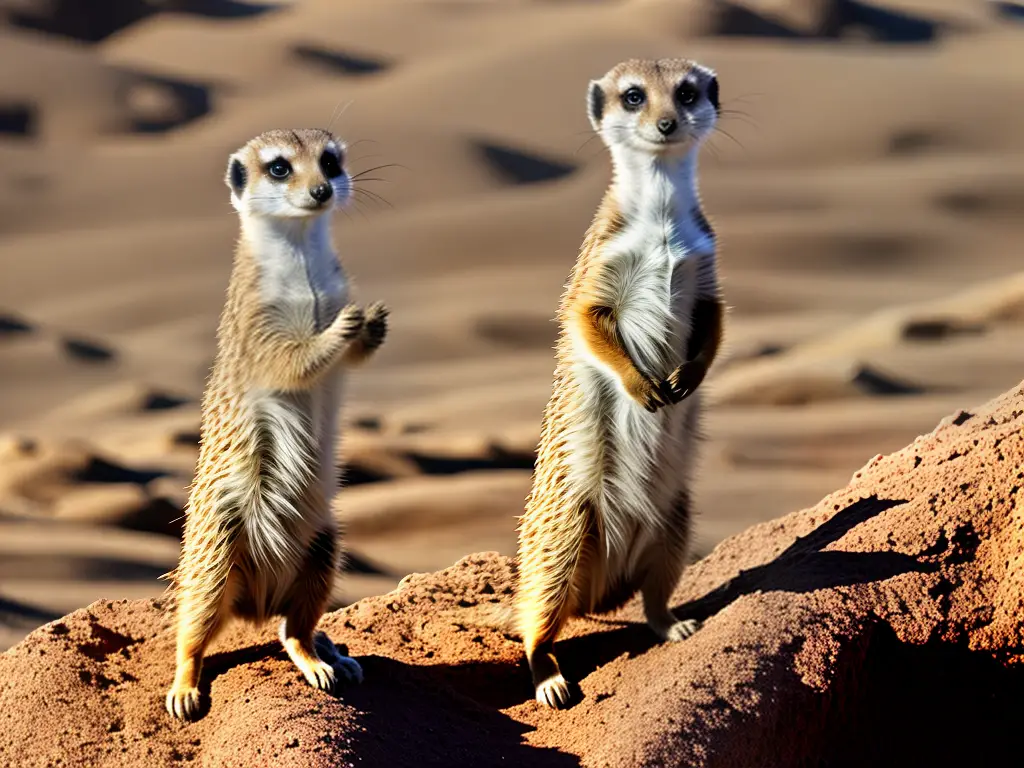Meerkats are small mammals found in the deserts of southern Africa. They are members of the mongoose family and are specifically classified as Suricata suricatta. These charming creatures are known for their social behaviors, living in groups called ‘clans’ or ‘mobs’. Meerkats are skilled burrowers and create a network of underground tunnels for shelter and protection from predators.
Meerkats have slender bodies with short legs, sharp-clawed and long, thin tails. Their average length is about 12 inches from nose to tail, and they typically weigh between 1.4 to 2.2 pounds. Meerkats have a light brown coat with darker stripes across their back for camouflage, making it easier for them to blend into their surroundings.
With their distinctive face markings, meerkats have dark patches around their eyes that help to reduce glare from the sun. They have large, curved ears that can be closed to keep out sand when they are digging. Meerkats also have long, curved front claws which are useful for digging burrows, foraging for food, and providing extra traction when they stand on their hind legs to survey their environment.
Meerkats are fascinating, small animals that live in the southern African region, specifically in countries like Angola, Botswana, Namibia, and South Africa. They can be found in different habitats such as open plains, savannas, and grasslands, which are known for their hot temperatures and harsh environment. Despite these conditions, Meerkats are excellent at adapting and spend much of their time foraging for food, including insects, small mammals, and reptiles. Occasionally, they may also consume fruit and vegetables when they are available.
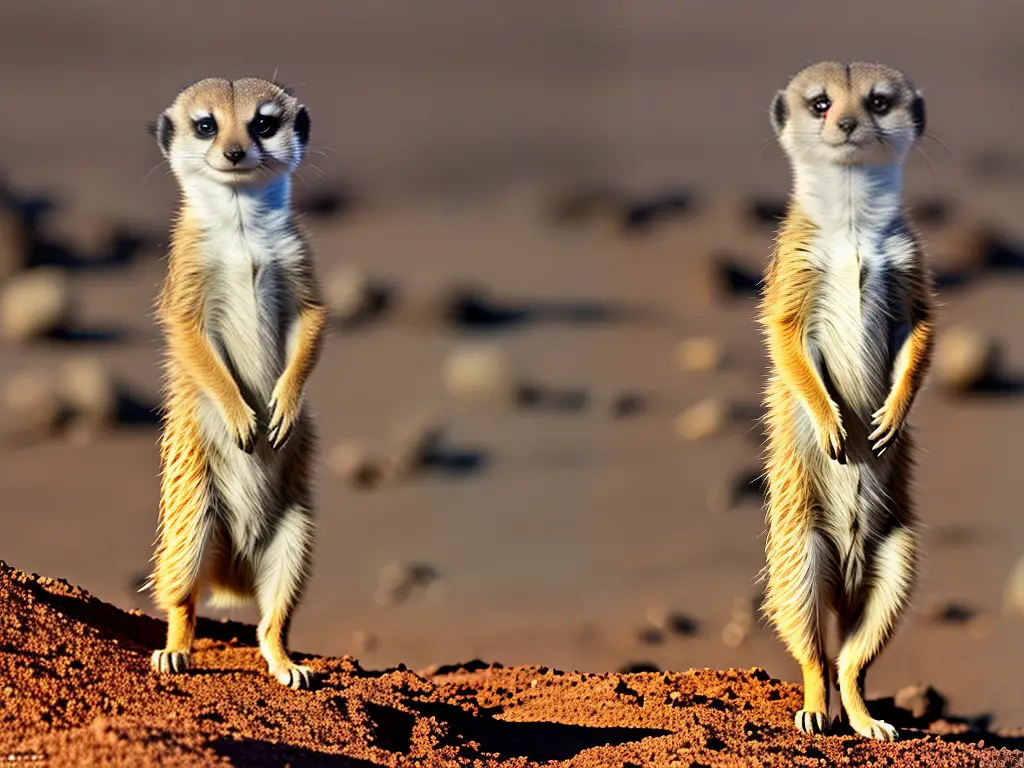
One of the most interesting aspects of Meerkats is their unique social structure and behavior. They live in groups called mobs, gangs, or clans, which can have around 20 to 30 members. These groups function like large families, where several adult meerkats help each other out and bring up the young ones together. This strong sense of unity and cooperation helps Meerkats thrive in their environment, ensuring their survival and well-being.
Within a meerkat group, there are specific roles that each member plays. The most important role is that of the alpha male and alpha female who are the dominant leaders of the group. They are responsible for making decisions, leading the group, and producing offspring. Other meerkats within the group have roles such as babysitters or sentinels. Babysitters take care of the young ones while the adults are busy foraging for food, and sentinels keep watch for potential threats while the rest of the group is busy eating or playing.
Meerkats are very social animals, and they communicate with each other through a variety of sounds, body postures, and facial expressions. They often make high-pitched calls to stay in contact with each other while foraging or to warn each other about dangers. They also use scent markings to communicate their territory, and they groom each other to strengthen the bonds within the group.
Meerkats are small mammals that live in the deserts of southern Africa. They have a very interesting diet that consists mainly of insects, but they also eat other small animals such as lizards, birds, and rodents, as well as some plant matter like roots and fruit. Meerkats have a special adaptation called ‘Elytra’, which helps them capture their prey. This is a special covering on their fingers that protects them from getting bitten or stung as they dig or grab insects.
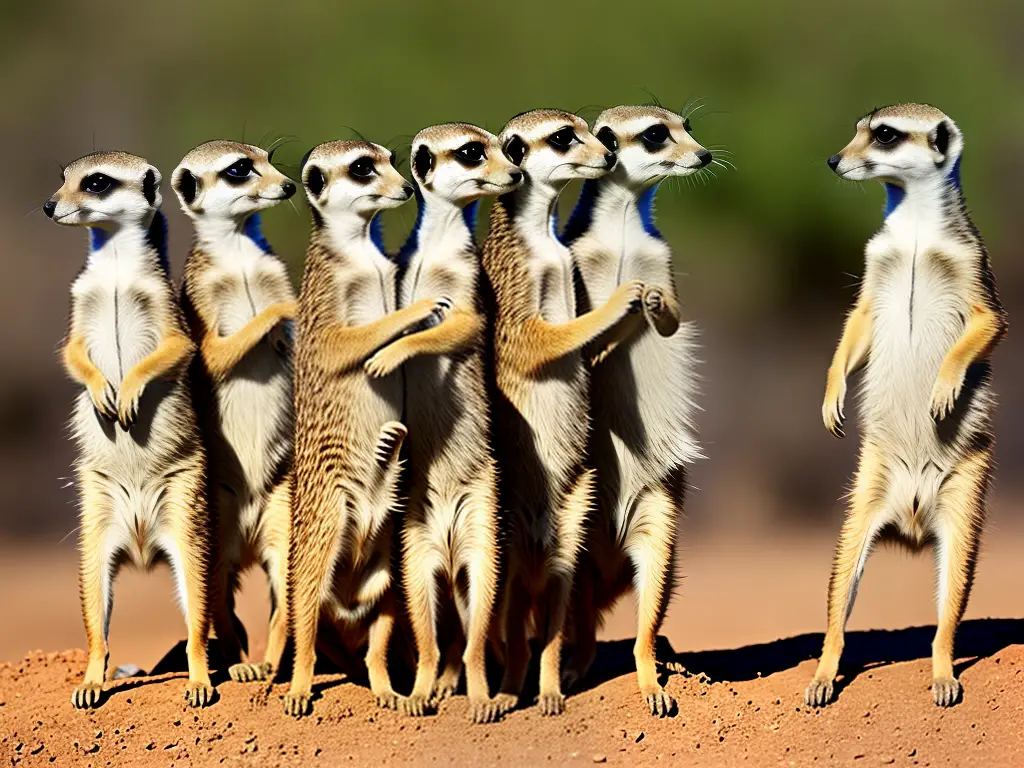
One of the interesting behaviors of meerkats is their habit of standing on their hind legs and scanning their surroundings for danger, known as ‘sentry duty.’ When a sentinel spots a potential threat, such as a predator, they alert the group through warning calls, and all the meerkats will quickly hide in their burrows until the danger has passed. This cooperative behavior helps to keep the entire group safe and is an essential part of their social structure, contributing to their overall life expectancy.
When it comes to foraging, meerkats are very social animals that work together in what is known as a ‘mob’ or ‘gang.’ This means that a large group of meerkats will work together to find food. One of the ways they do this is through a process called ‘cooperative foraging.’ This means that while one meerkat is digging for food, others are watching out for predators like snakes and birds of prey. If a threat is spotted, the meerkats will give out a warning call so that everyone can escape to safety.
While searching for food, meerkats use their sharp claws to dig in the sand and their sensitive noses to sniff out their prey. They can quickly locate insects like beetle larvae, scorpions, and spiders hiding in the ground. Once they find their prey, meerkats will quickly catch it with their sharp teeth and eat it on the spot. They may also save some of the food to bring back to their family members that stayed behind at the burrow, especially the young ones and those taking care of them.
Meerkats are fascinating animals that live in groups called ‘clans’ or ‘mobs’, and group meals play an essential role in their lives. These meals help to strengthen the bond between the members of the mob as they forage together, communicate with each other using a range of calls and body language, and share information about the location of food sources, potential dangers, and other important updates. By working together during group meals, meerkats ensure that everyone in the mob gets enough to eat and stays safe from predators.
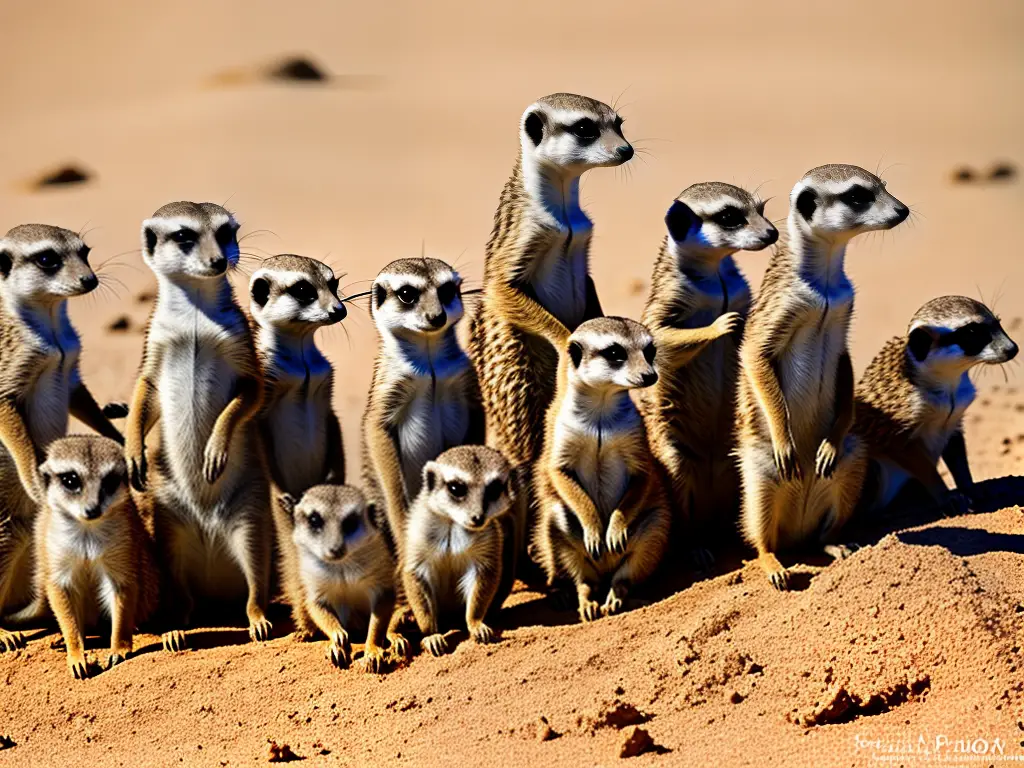
In addition to their group meal habits, meerkats also have unique breeding practices within their clans. Each clan is led by a dominant female and a dominant male, and these dominant meerkats are often the only ones allowed to mate and have babies in the group. This selective breeding strategy helps prevent overcrowding and ensures there are enough resources for all the members of the clan. By living and working together in this way, meerkats maintain a strong social structure that supports their life expectancy and overall well-being.
When a female meerkat is ready to have babies, she will mate with the dominant male. The gestation period, or the time it takes for baby meerkats to grow inside the mother, is usually around 11 weeks. After this time, the mother will give birth to her babies, called ‘pups.’
Meerkat litters can have anywhere from 2 to 5 pups, although sometimes there are more. The pups are very small and helpless when they are born, with their eyes and ears closed. They rely on their parents and other members of the clan to take care of them and keep them safe.
Meerkats, also known as suricates, are small mammals that live in the deserts and savannas of southern Africa. In this environment, meerkat families share the duty of caring for the young, with other adults and older siblings helping to teach them how to survive. This includes learning how to find food, avoid predators, and interact with other meerkats.
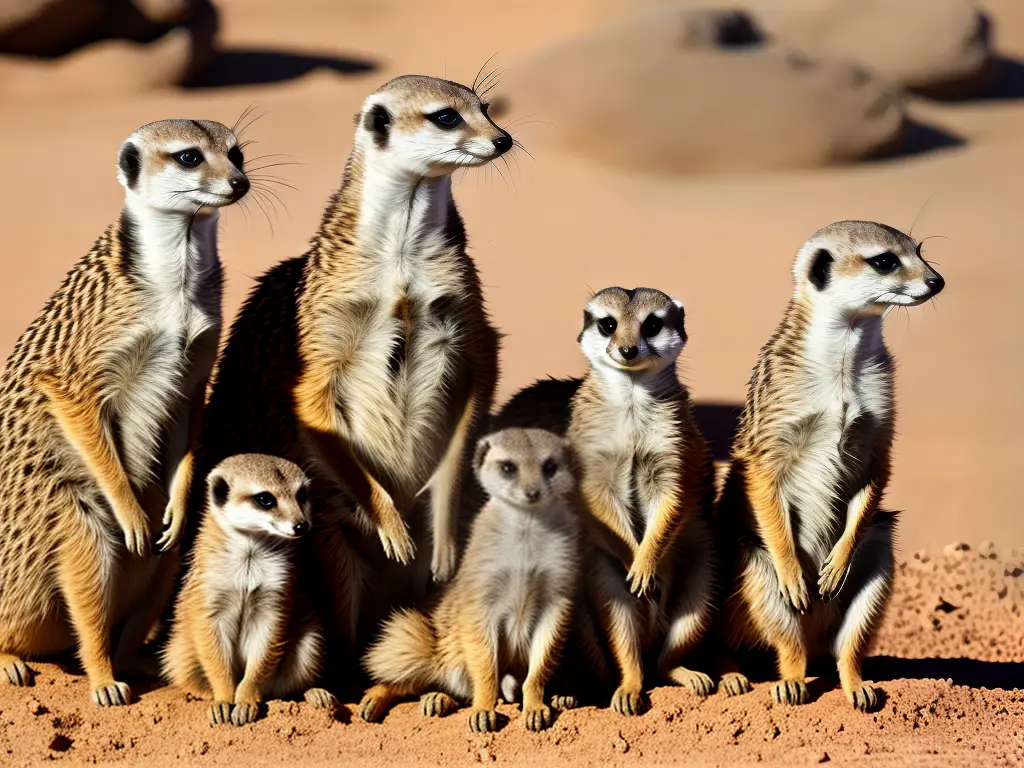
After around 3 months, the meerkat pups are ready to fully join the group and start participating in activities with the rest of the clan. Throughout their lives, meerkats face a variety of predators and threats, such as birds of prey like eagles and hawks, and carnivorous animals like jackals, snakes, and wild cats. These predators often try to hunt meerkats for food, making their life expectancy an important factor to consider.
One of the ways meerkats defend themselves against predators is by living in large family groups called ‘clans’ or ‘mobs’. These groups can have as many as 40 members, and they help to watch out for one another while foraging for food. While some meerkats look for insects and small animals to eat, others stand guard, acting as a lookout for signs of danger. If a predator is spotted, the lookout meerkat will emit a loud alarm call to alert the rest of the group.
Meerkats are also known for their excellent digging abilities, which is an essential part of their defensive strategy. They create underground burrows with multiple entrances and chambers, which serve as a shelter from predators and harsh weather conditions. When a threat is detected, meerkats can quickly retreat to their burrows, using their sharp claws to dig and block the entrances if necessary.
In addition to their group behavior and digging skills, meerkats boast several other adaptations to help them avoid danger. Their brown and gray fur helps them blend in with their environment, which makes it harder for predators to spot them. Moreover, these small mammals native to the grasslands and deserts of southern Africa have excellent eyesight that allows them to spot predators from a distance.
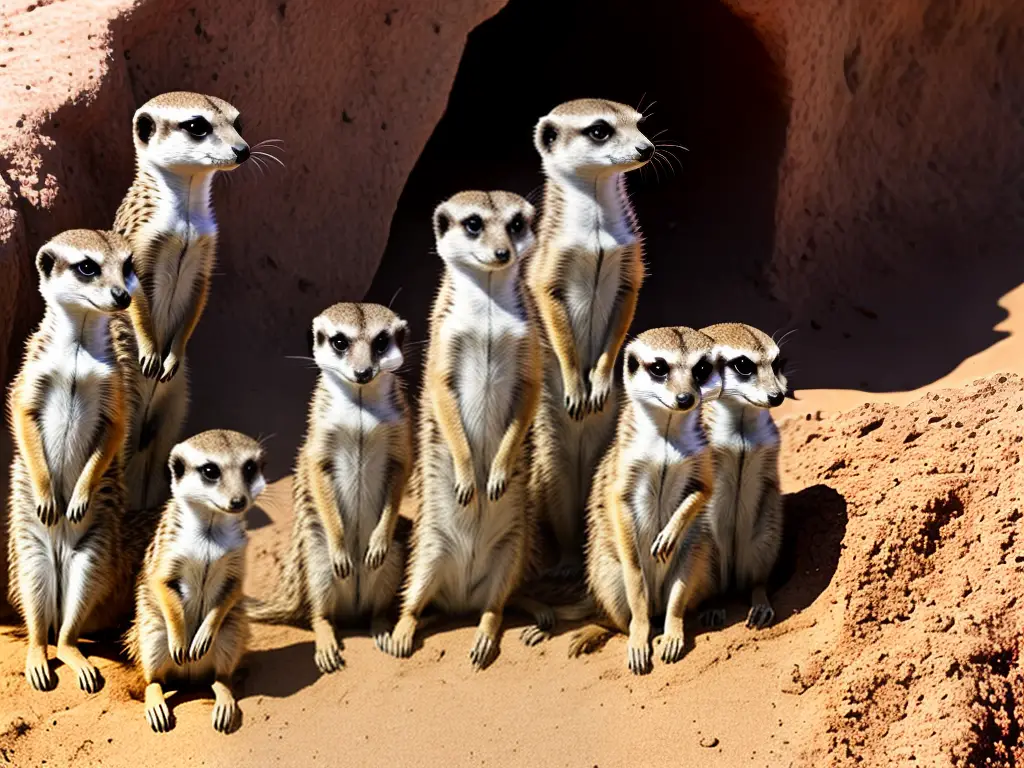
Meerkats live in large social groups called clans or mobs, which help them survive in harsh environments. The typical life span of a meerkat in the wild is around 6 to 7 years, although some may live up to 10 years or more. In captivity, where they are protected from predators and diseases, meerkats enjoy a longer life, sometimes exceeding 15 years.
There are various factors that affect the life expectancy of meerkats. One of the most important factors is their social structure. Meerkats live in groups, and each member of the group has a specific role. The dominant female, called the alpha, is the main breeding female and leader of the clan. She gives birth to most of the babies and is responsible for leading the group to find food and water. Other members of the group help with raising the young, grooming each other, and keeping a lookout for danger. The cooperative behavior of meerkats helps to protect them from predators and extend their life expectancy.
Another significant factor that affects meerkat’s longevity is their diet. Meerkats are omnivorous animals, which means they eat both plant and animal matter. They mainly feed on insects, small rodents, and birds, but they also eat fruits and vegetables when available. This diverse diet provides them with essential nutrients and energy to survive in their harsh environments. Having a balanced diet helps maintain their overall health and increases their life span.
Like all animals, meerkats can suffer from various health issues. Parasites are a common problem for meerkats, as they can become infested with ticks, fleas, and intestinal worms. These parasites can cause itching, infection, and digestive problems, potentially leading to illness and shortened life expectancy. Injuries sustained during fights with other meerkats or confrontations with predators may also lead to infections or long-term disabilities. Meerkats are also susceptible to certain diseases, such as tuberculosis, which can be fatal if not treated. Regular monitoring and care can help prevent and treat these health issues for meerkats, especially those living in captivity.
